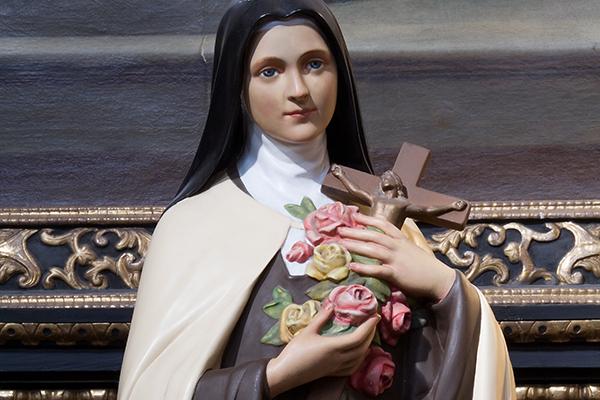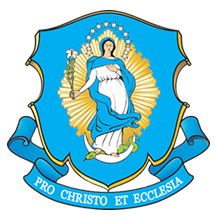
“I shall spend my heaven in doing good upon earth.”
By Kimberly Bruce
One of the most highly recognizable saints of the modern age is St. Thérèse of Lisieux, whose feast we celebrate on Oct. 1. Also known as “The Little Flower,” she was only 24 years old when she died. Yet she is a Doctor of the Church, sharing the designation with only four other women in Church history: Sts. Hildegard of Bingen, Catherine of Siena, and Teresa of Avila.
Saint of the “Little Way”
Famous for her “Little Way” of achieving sanctity, her “contribution to spirituality is as original as it is profoundly traditional,” said Paul Marie de la Croix in St. Thérèse’s Life in the Carmel of Lisieux and the Influence of Her “Little Way.”
This “Little Way,” continued Paul Marie, “may be expressed in this sentence: We are, in Christ, God’s children and we ought to love our Father in heaven with a filial love full of confidence and abandonment.”
Like St. Faustina, St. Thérèse had great confidence and trust in God, His love, and His mercy. With that trust, she was able to detach herself from the things of this world and obtain great humility.
Saintly parents
One of nine children born to holy parents Louis and Zelie Martin (both canonized as saints in 2015), St. Thérèse was born Jan. 2, 1873, in Alencon, France. Four Martin children died in infancy; the other five, all daughters, became nuns. When Thérèse was 4 years old, her mother passed away, and the family moved to Lisieux.
In 1883, on Pentecost Sunday, St. Thérèse experienced a miraculous healing from a serious illness through the intercession of Our Lady of Victories. The following year, at age 11, she received both her First Holy Communion and the Sacrament of Confirmation.
Wishing to enter religious life, Therese sought contemplative life at the Carmel of Lisieux, like sisters Pauline and Marie. She was denied entrance, however, because of her young age.
During a trip to Italy with her father in 1887, she was present during an audience with Pope Leo XIII in Rome. Saint Thérèse boldly asked the Holy Father if he would permit her to enter Carmel at the age of 15. His response: “Go … go … You will enter if God wills it!”
She was permitted entrance the following year. While at Carmel, she aided several missionaries spiritually, by her prayers and sacrifices for them. She wished to be a missionary in China. After eight years of being at Carmel, however, she began suffering symptoms of tuberculosis, which claimed her life a year later.
During her years at Carmel, Thérèse was unable to feel our Lord’s presence or consolations. Nevertheless, she remained confident of His love, saying, “You may sleep in my boat; I shall not awaken You. You are hiding Yourself, but I know well where You are hidden: You are in my heart. I do not feel it, but I know it. I believe in Your love for me and I believe in my love for You” (from I Believe in Love: A personal retreat based on the teaching of St. Thérèse of Lisieux by Fr. Jean C. J. D’Elbee).
The power of the Word
Certain passages of Scripture left deep impressions upon St. Thérèse; for instance, Matthew 18:3, where Jesus says, “Truly I tell you, unless you change and become like children, you will never enter the kingdom of heaven.” Another was Matthew 5:3: “Blessed are the poor in spirit, for theirs is the kingdom of heaven.”
These passages inspired St. Thérèse to want to remain “little,” like a child, to obtain all the graces she could from God, much like a mother bestowing the most care upon the littlest of her children.
She knew she could not do great things in life, but she could do little things with great love. She realized by being humble, having complete confidence in God, and doing everything in her life with love, she could become a saint.
Missionary zeal
Two episodes in St. Thérèse’s life inspired her missionary zeal and intercessory prayer for others, said Pope Francis on June 7, 2023. The first was when, at age 14, “God worked a miracle in her heart,” by stirring her “out of the prison of her selfishness and self-pity” following an episode in her family home. Afterwards, said the Pope, “instead of seeking consolations for herself, she set out to ‘console Jesus, [to] make him loved by souls.’”
The second episode, said Pope Francis, was when she prayerfully interceded for a murderer destined to die by the guillotine who showed no desire for God’s mercy. After his death, she read in a newspaper that just before he died, he had “grabbed a Crucifix … and kissed three times the sacred wounds” of Christ. “Such is the power of intercession moved by charity,” said the Pope.
Saint Thérèse’s superiors ordered her to write her autobiography, completed just before her death, entitled Story of a Soul: The Autobiography of St. Thérèse of Lisieux.
Since the Little Flower’s death in 1897, countless miracles have been attributed to her intercession, fulfilling her prophesy: “I shall spend my heaven in doing good upon earth.”
She was canonized as St. Thérèse of the Child Jesus and of the Holy Face (her religious name) in 1925 by Pope Pius XI and declared a Doctor of the Church during the centennial anniversary of her death in 1997 by Pope St. John Paul II.
Saint Thérèse of Lisieux, Doctor of the Church, pray for us!
Photo by Jorge Royan/Wikicommons
{shopmercy-ad}
















